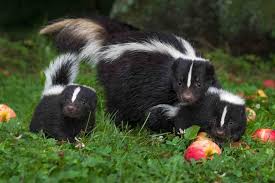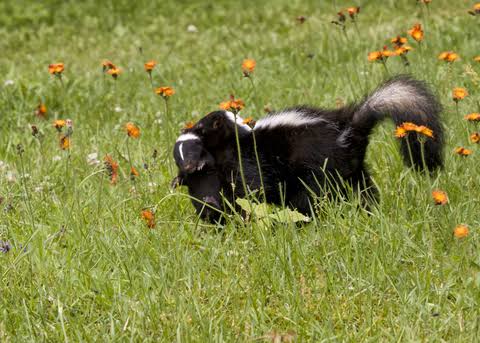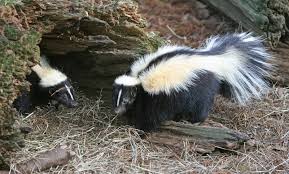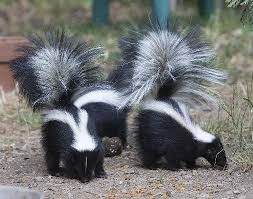Skunks, scientifically known as Mephitis mephitis, are fascinating creatures that capture our attention with their distinctive black and white coloration. These small mammals belong to the family Mephitidae and are renowned for their ability to spray a pungent liquid as a defense mechanism.
In North America, skunks are commonly found in various habitats, including forests, grasslands, and urban areas. Their adaptable nature allows them to thrive in diverse environments. Skunks are nocturnal, meaning they are most active during the night, and they have a keen sense of smell and hearing, which aids them in locating food.
One notable feature of skunks is their striking color pattern, which serves as a warning to potential predators. This bold black and white coloration is a clear indication of the skunk’s potent defense mechanism. When threatened, a skunk can release a spray from glands located near its tail. This spray contains sulfur compounds, producing a strong and unpleasant odor that deters predators and even humans.
Skunks are omnivores, meaning they eat a variety of foods. Their diet includes insects, small mammals, fruits, and plants. This adaptability in diet contributes to their ability to thrive in different ecosystems.
During the spring, skunks enter their mating season, and females give birth to a litter of kits. The young skunks remain with their mother until they are old enough to venture out on their own. Skunks are generally solitary animals, but they may form loose groups, especially during the mating season.
Despite their reputation for the malodorous spray, skunks play a crucial role in controlling insect populations. They are efficient hunters of insects and can help keep pest populations in check. However, it’s essential for humans to be cautious around skunks to avoid any unwanted encounters.
Skunks are intriguing creatures with a unique set of characteristics. From their nocturnal habits to their distinctive coloration and defensive spray, skunks hold a special place in the natural world. As we coexist with these fascinating mammals, it’s important to appreciate their role in maintaining ecological balance while respecting their need for space and safety.
Read Also: Guide to Proper Management of Weaners
Animals and Plants Affected by Skunks (Mephitis mephitis)

Skunks can have an impact on various animals and plants in their environment. While they are generally beneficial in controlling insect populations, their defensive spray and foraging behavior can influence other species.
1. Insects: Skunks are skilled insect hunters, and their diet often includes insects such as beetles, grasshoppers, and caterpillars. By preying on these pests, skunks contribute to natural pest control, benefiting plants and crops.
2. Small Mammals: Skunks may target small mammals like rodents when hunting for food. This can affect the population dynamics of these smaller animals in the ecosystem.
3. Birds: Skunks might raid bird nests for eggs or nestlings. This can impact bird populations, especially ground-nesting species vulnerable to skunk predation.
4. Amphibians and Reptiles: Skunks are opportunistic feeders and may consume amphibians and reptiles. This predation can influence the abundance and diversity of these species in a given habitat.
5. Plants: Skunks can indirectly impact plants by controlling herbivorous insect populations. By reducing the number of plant-eating insects, skunks contribute to plant health and may influence the overall vegetation in their habitat.
6. Garden and Agricultural Crops: While skunks are beneficial in controlling insect pests, their foraging habits can sometimes lead to damage in gardens or agricultural fields. Rooting for insects or grubs, they may disturb the soil and plant roots.
7. Human Interaction: Skunks can affect human activities, particularly in urban and suburban areas. Encounters with skunks may lead to their defensive spray being released, causing temporary discomfort for humans and pets.
Understanding the ecological role of skunks and their interactions with other species is essential for maintaining a balanced ecosystem. While they contribute to pest control, the potential impact on certain animals and plants highlights the complex dynamics of wildlife interactions in nature.
Damages Caused by Skunks

Skunks, while playing a valuable role in natural pest control, can sometimes cause damages that may be undesirable for humans and other animals. Here are some potential damages caused by skunks:
1. Defensive Spray: The most well-known damage caused by skunks is their defensive spray. When threatened, skunks release a strong-smelling liquid from glands near their tails. This spray can cause discomfort for humans and pets, and the odor is difficult to remove.
2. Gardens and Lawns: Skunks may dig in gardens or lawns in search of insects, grubs, or small rodents. This foraging behavior can lead to upturned soil, damaged plants, and disrupted landscaping.
3. Feeding on Poultry and Eggs: In rural areas, skunks may pose a threat to poultry farms by preying on chickens and raiding nests for eggs. This can result in economic losses for poultry keepers.
4. Structural Damage: Skunks may occasionally seek shelter in or under structures such as sheds, decks, or porches. This can lead to structural damage as they create burrows or nests, potentially affecting the stability of these constructions.
5. Nesting in Unwanted Areas: Skunks might choose inconvenient locations for their nests, such as crawl spaces or under buildings. This can be problematic for homeowners, leading to disturbances and potential damage to property.
6. Transmission of Diseases: While skunks are not major carriers of diseases, they can transmit rabies. This poses a health risk to humans and pets if bitten or scratched by an infected skunk.
7. Impact on Beehives: Skunks are known to be attracted to beehives, especially during periods when other food sources are scarce. They may disturb beehives in search of honey or bee larvae.
8. Impact on Amphibians and Reptiles: Skunks may prey on amphibians and reptiles, potentially affecting the populations of these species in certain habitats.
It’s important to note that while skunks can cause these damages, they also provide valuable ecological services by controlling insect pests. Efforts to mitigate conflicts with skunks often involve preventive measures, such as securing trash, sealing potential entry points to structures, and using repellents where appropriate. Understanding and respecting the natural behavior of skunks can help in finding solutions that balance their role in ecosystems with human concerns.
Read Also: Guide to Proper Management of Growing and Finishing Pigs
Control and Preventive Measures

Controlling and preventing conflicts with skunks often involves a combination of humane methods and proactive measures to discourage their presence. Here are some strategies:
1. Secure Garbage Bins: Ensure that garbage bins are securely closed to limit access to potential food sources. Skunks are attracted to food waste, and securing trash can discourage their presence.
2. Remove Attractants: Limit access to pet food, bird feeders, and fallen fruits. These items can attract skunks, and removing them reduces the likelihood of encounters.
3. Seal Entry Points: Skunks may seek shelter under structures. Seal potential entry points to sheds, decks, and crawl spaces to prevent skunks from nesting in unwanted areas.
4. Install Motion-Activated Lights: Skunks are nocturnal, and they are sensitive to light. Installing motion-activated lights can deter skunks from approaching certain areas, making them uncomfortable in well-lit spaces.
5. Use Repellents: Commercial or homemade repellents with scents that skunks find unpleasant can be applied in targeted areas. Common ingredients include citrus, ammonia, or pepper. However, these should be used with caution to avoid harm to the skunk or other non-target species.
6. Fencing: Installing fences can help protect gardens and lawns from skunk foraging. Fences should extend below ground to prevent digging, and the top should be angled outward to deter climbing.
7. Trapping and Relocation: In some cases, trapping and relocating skunks may be considered. However, this should be done by professionals, as mishandling can result in stress for the skunk and is often subject to local regulations.
8. Modify Landscaping: Trim vegetation and remove brush piles where skunks might seek shelter. An open and well-maintained landscape may make the area less attractive to skunks.
9. Educate and Encourage Coexistence: Informing residents about skunk behavior and the importance of coexisting with wildlife can promote understanding. Encourage responsible practices to minimize conflicts.
It’s crucial to approach skunk control with a focus on humane and environmentally friendly methods. Always consider local regulations and consult with wildlife professionals if needed. The goal is to create an environment that minimizes attractants while respecting the natural behavior of skunks and other wildlife.
Frequently Asked Questions (FAQs) About Skunks (Mephitis mephitis)
1. Q: What should I do if I encounter a skunk?
A: If you encounter a skunk, remain calm and move away slowly. Skunks may spray if they feel threatened, so avoid sudden movements and loud noises.
2. Q: Can skunks transmit diseases?
A: Skunks can carry diseases such as rabies. It’s important to avoid close contact and seek medical attention if bitten or scratched by a skunk.
3. Q: How can I prevent skunks from digging in my garden?
A: Secure garbage bins, remove food sources, and use fencing to protect gardens. You can also apply repellents or modify the landscaping to make the area less appealing to skunks.
4. Q: What do skunks eat?
A: Skunks are omnivores and eat a variety of foods, including insects, small mammals, fruits, and plants. They play a role in natural pest control by consuming insects.
5. Q: How can I avoid getting sprayed by a skunk?
A: Keep a safe distance, avoid sudden movements, and make yourself known if you encounter a skunk. Back away slowly to give the skunk an opportunity to retreat without feeling threatened.
6. Q: Do skunks hibernate?
A: Skunks do not hibernate but may become less active during extremely cold weather. They may create a den and stay in it for longer periods, but they do not enter a true hibernation state.
7. Q: Can I relocate a skunk if it becomes a nuisance?
A: Relocating skunks should be done by professionals, as mishandling can cause stress to the skunk. It’s also important to be aware of local regulations regarding trapping and relocation.
8. Q: How can I deter skunks from living under my porch or deck?
A: Seal potential entry points, install motion-activated lights, and use repellents. Creating an environment that is less inviting for nesting can discourage skunks from residing in unwanted areas.
9. Q: What is the lifespan of a skunk?
A: In the wild, skunks typically live around 2 to 4 years. Factors such as predation, disease, and human interactions can influence their lifespan.
10. Q: Are skunks beneficial to the environment?
A: Yes, skunks play a beneficial role in the ecosystem by controlling insect populations. Their omnivorous diet helps regulate pest numbers, contributing to natural pest control.
Read Also: How to Get Into College

